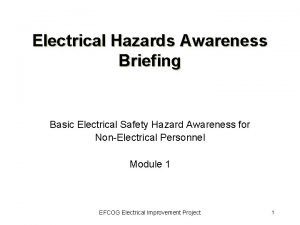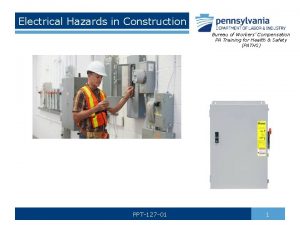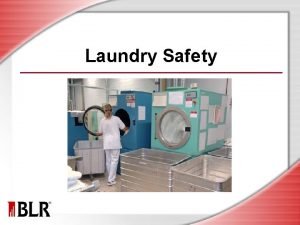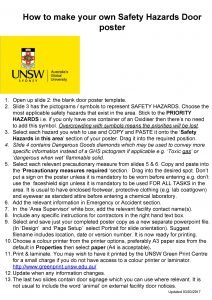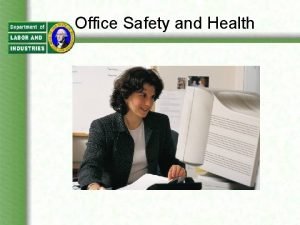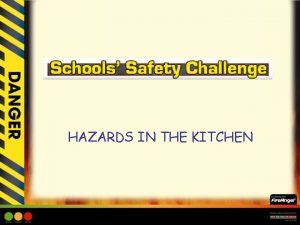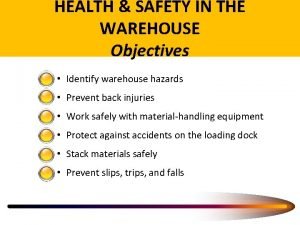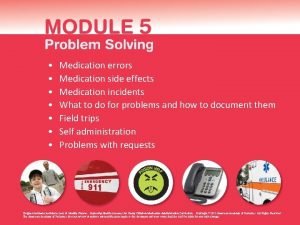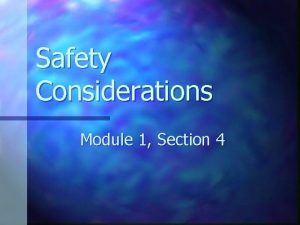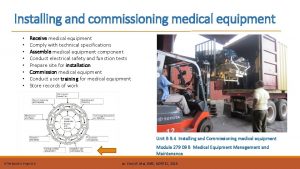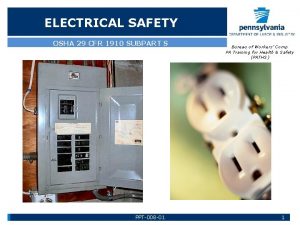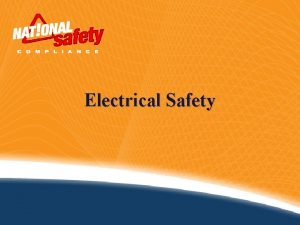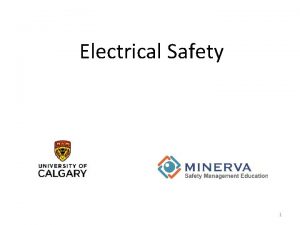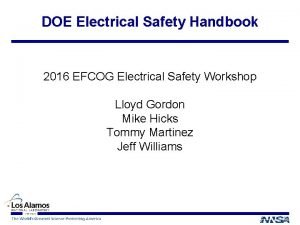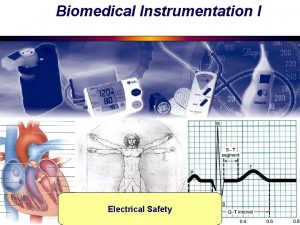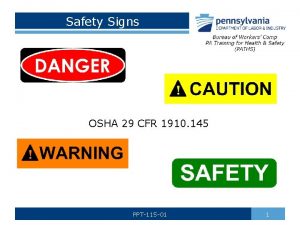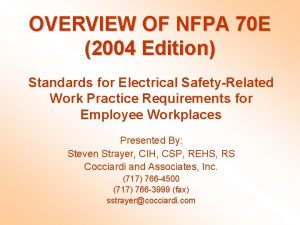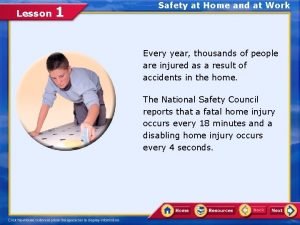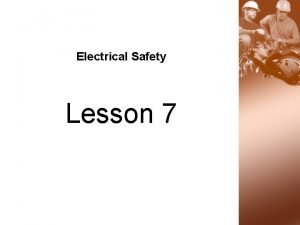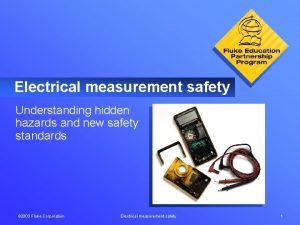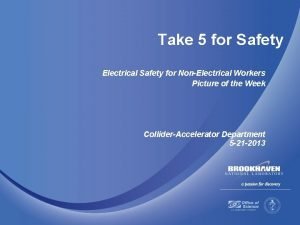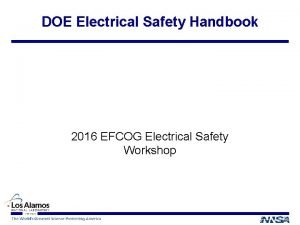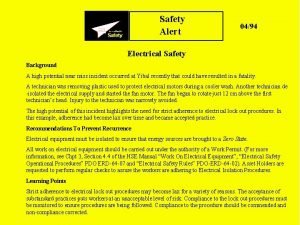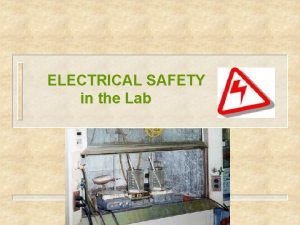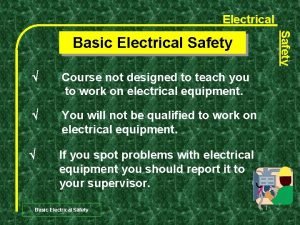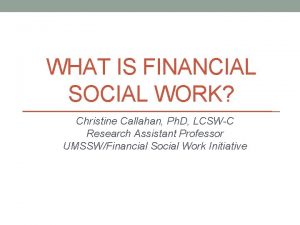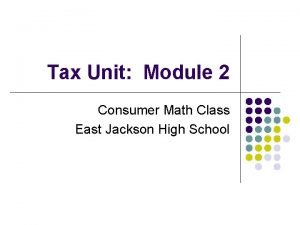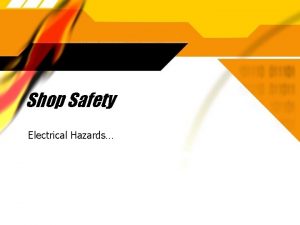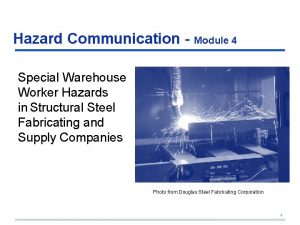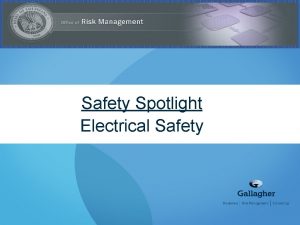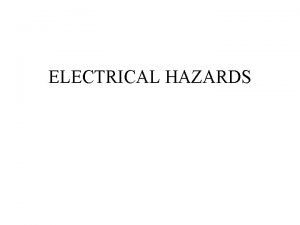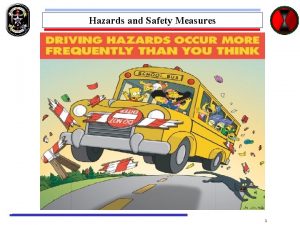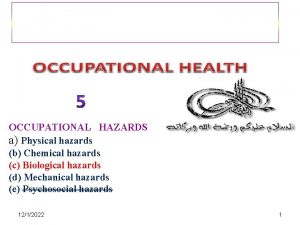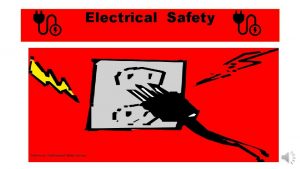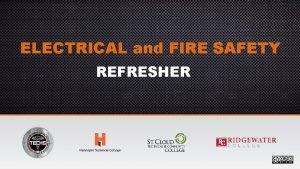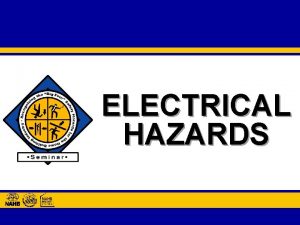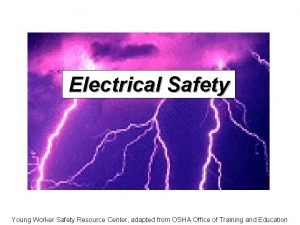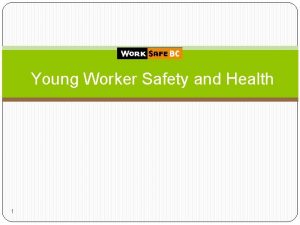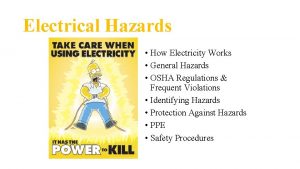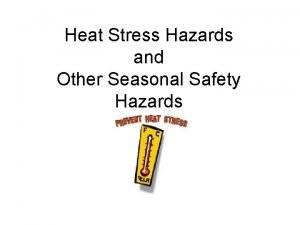Electrical Safety Module 6 Electrical Warehouse Worker Hazards


















































- Slides: 50

Electrical Safety - Module 6 Electrical Warehouse Worker Hazards in Structural Steel Fabricating and Supply Companies 1

Electrical Safety - Module 6 OSHA Grant Information This material was produced under grant number SH-26316 -SH 4 from the Occupational Safety and Health Administration, U. S. Department of Labor. It does not necessarily reflect the views or policies of the U. S. Department of Labor, nor does mention of trades names, commercial products, or organizations imply endorsement by the U. S. Government. 2

Electrical Safety – Module 6 This program was developed by faculty and students in the School of Planning Design and Construction at Michigan State University in conjunction with the American Institute of Steel Construction - Safety Committee and the University of Puerto Rico March 2015 3

Electrical Safety - Module 6 Learning Outcomes: Participants shall be able to: q Demonstrate understanding of the risks of working with electricity q Demonstrate ability to recognize electrical safety hazards q Demonstrate understanding of safe use of cords q Demonstrate understanding of the need for de-energizing for routine parts replacement such as changing drill bits, blades etc. q Demonstrate understanding of the need to Lock/Tagout equipment when servicing equipment 4

Electrical Safety - Module 6 Special Issues for fabrication and supply companies q Safe electrical use of all shop tools and equipment q Routine maintenance and changing out of tools such as drill bits or punches requires de-energizing the tool. The company should have procedures to isolate energy for routine shop practices (changing bits, dies blades) q Anything with energy potential needs to be locked out and tagged before guards can be removed q When electrical parts are exposed the power needs to be removed and locked out q Only qualified electricians may service electrical components q Electricians should use PPE 5

Electrical Safety - Module 6 Employers are responsible for complying with: q OSHA 1910 Subpart S And applicable editions of: q NFPA 70 E® Standard for Electrical Safety in the Workplace q The National Electrical Code (NEC) q NFPA® 70 B Electrical Equipment Maintenance. http: //catalog. nfpa. org/2015 -NFPA-70 Ereg-Standard-for-Electrical-Safety-in-the-Workplace-P 1197. aspx 6

Electrical Safety - Module 6 What causes shocks? q Electricity travels in circuits-normally through a conductor q Sometimes a person’s body mistakenly becomes part of the circuit causing electrical shocks Adapted from SH-20 -843 -SH 0 7

Electrical Safety - Module 6 What causes shocks? Shocks occur when a person’s body completes the current path with: q “Both wires of an electrical circuit q One wire of an energized circuit and the ground q A metal part that accidently becomes energized q Another conductor that is carrying the current” When a person receives a shock, current flows through the body and the ground Source OSHA 3075 -2002 (Revised) 8

Electrical Safety - Module 6 Factors impacting severity of shock q “Amount of current flowing through the body q The current’s path through the body q The length of time the body remains in the circuit q The current frequency” q Quality of grounding q Working in wet conditions q Dryness or wetness of skin Source OSHA 3075 -2002 (Revised) 9

Electrical Safety - Module 6 Milliamperes and Amps q 1000 milliamperes = 1 Amp Typical Tools and Rated Amperage q Typical (hand held) ½ portable drill 4 -7 Amps q Industrial Drill Press 10 -15 Amps q Grinder (hand held) 15 Amps 10

Electrical Safety - Module 6 Effects of Electric Current and Body Reaction “Below 1 milliamp Generally not perceptible 1 milliamp Faint tingle 5 milliamps Slight shock felt; not painful but disturbing. Average individual can let go. Strong involuntary reactions can lead to other injuries. Women) 6– 25 milliamps ( 9– 30 milliamps (Men) Painful shock, loss of muscular control* The freezing current or “let-go” range. * Individual cannot let go, but can be thrown away from the circuit if extensor muscles are stimulated. ” Source: Next slide 11

Electrical Safety - Module 6 Effects of Electric Current in the Human Body “ 50 – 150 milliamps Extreme pain, respiratory arrest, severe muscular contractions. Death is possible. 1, 000 – 4, 300 milliamps Rhythmic pumping action of the heart ceases. Muscular contraction and nerve damage occur; death likely. 10, 000 milliamps Cardiac arrest, severe burns; death probable” Source OSHA 3075 -2002 (Revised) Source: W. B. Kouwenhoven, “Human Safety and Electric Shock, ” Electrical Safety Practices, Monograph, 112 , Instrument Society of America, p. 93. November 1968. 12

Electrical Safety - Module 6 Other Effects - Burns q Electrical Burns q Arc Flash Burns q Thermal Contact Burns 13

Electrical Safety - Module 6 Arc Flash “An arc flash is a short circuit through the air in an electrical panel box or any other piece of energized electrical equipment. ” “The circuit is completed through the air, the air breaks down to where it offers little‐to‐no resistance to the flow of electricity. ” “The tremendous amounts of energy released in an arc flash make for a very bright, very hot, and very loud explosion. ” Source SH‐ 20999‐ 10‐ 60‐F‐ 21 14

Electrical Safety - Module 6 Arc Flash- Causes q Dropped tools in panels, inadvertent contact during servicing of equipment, corrosion of components, moisture, animals q Only qualified individuals should work on electrical equipment Source SH‐ 20999‐ 10‐ 60‐F‐ 21 15

Electrical Safety - Module 6 Arc Flash- Protective Measures q NFPA 70 E® Standard for Electrical Safety in the Workplace identifies practices which can help reduce arc flash potential and injury Source SH‐ 20999‐ 10‐ 60‐F‐ 21 16

Electrical Safety - Module 6 Arc Flash- Protective Measures q Electrical Equipment should only be serviced by a qualified individual q Wear all PPE q De-energize the circuit q Use Safe Work Practices q Insulation q Guarding q Ground Fault Circuit Interrupters (GFCI) q Grounding (secondary protection) q Barricades q Limited Approach Zones q Restricted Approach Zones q Prohibited Approach Zones Source SH‐ 20999‐ 10‐ 60‐F‐ 21 17

Electrical Safety - Module 6 Arc Flash- Protective Measures For more information AISC has an Arc Flash Webinar posted at its website http: //www. aisc. org/content. aspx? id=35368 18

Electrical Safety - Module 6 q Electricity can cause explosions and or fires if the conditions are right. q Bad insulation, static electricity, and overloaded circuits all contribute to explosions. 19

Electrical Safety - Module 6 What is an electrical circuit? q Electricity flows from a voltage source through a conductive path to a load and returns to the voltage source Neutral Hot wire Grounding wire 20

Electrical Safety - Module 6 Polarity Certain electrical using devices are sensitive to polarity so it is important that circuits be wired properly and proper plugs are used. Larger slot and third prong limits reversing polarity 21

Electrical Safety - Module 6 Insulating the Conductors q. Simplest way to protect workers from energized wires is by insulation q. Rubber/plastic coatings on wires prevent shock, fires, short circuits and provide strain relief q Must be suitable for voltage q. Check insulation on cords and equipment before using them q. Small defects in cords and equipment will allow leakage q Insulation is subject to damage Cover on electrical cord serves as insulation 22

Electrical Safety - Module 6 Types of grounding protection Equipment is grounded through the use of a grounding conductor- usually a copper wire that is insulated with a green cover or a bare copper or stranded copper wire. Electrical systems components such as hard wired equipment and fixture boxes are grounded back to the electrical panel which is grounded to the ground through ground rods. Source OSHA 3075 -2002 (Revised 23

Electrical Safety - Module 6 The importance of grounding protection q Grounding a tool intentionally creates a low resistance path that connects to the earth q Secondary protective measure that helps protect a worker q Does not guarantee you won’t get a shock-but reduces the risk For grounding prong Ground screw 24

Electrical Safety - Module 6 Types of grounding protection q Fuses q Circuit Breakers Located at the panel or at the device and break the circuit when too much current flows through the circuit. q Ground - Fault Circuit Interrupters (GFCI) Source OSHA 3075 -2002 (Revised 25

Electrical Safety - Module 6 Ground-Fault Circuit Interrupters 1/10 of an ampere (amp) of electricity going through the body for just 2 seconds is enough to cause death. A GFCI can sense a current differential due to a ground fault and breaks the circuit Image from https: //www. osha. gov/SLTC/etools/construction/electrical_incidents/gfci. html 26

Electrical Safety - Module 6 Ground Fault Circuit Interrupters q. Can detect a change in current of 5 millamperes and shut off power in less than 1/40 of a second. q. Can be installed in the service entrance panel, receptacle, branch circuit panel, extension cord or with generators. Source OSHA 3075 -2002 (Revised) 27

Electrical Safety - Module 6 GFCI Should be used whenever work will be done in a possibly wet environment such as outdoors, basements, garages or an other potentially wet location. GFICI test and reset buttons 28

Electrical Safety - Module 6 https: //www. osha. gov/SLTC/etools/construction/electrical_incidents/powertools. htm 29 l

Electrical Safety - Module 6 Double Insulated Tools Double insulated drill Double box on label indicates double insulated tool 30 https: //www. osha. gov/SLTC/etools/construction/electrical_incidents/powertools. htm

Electrical Safety - Module 6 Assured Equipment Grounding Program OSHA 1910 Subpart S q Alternative to GFCI protection. q By shift inspection of cords to guarantee continuity of grounding conductor and correct connection of conductor (polarity) q Must have daily inspection for missing pins, insulation damage, internal damage q Inspection must be done by competent person q Keep records Source 1910. 304 31

Electrical Safety - Module 6 Safe Practices-Guard Conductors q. Protect workers from energized lines by guarding/shielding the wires q. Use boxes, covers, enclosures and conduit to prevent contact with wires q. Boxes/panels must be free of missing ‘knock-outs’ q. Electrical equipment operating at 50 volts or more must be guarded Missing knockout Open box 32

Electrical Safety - Module 6 Safe Practices- Using equipment-Grounding q q q q q Use GFCIs or have an assured equipment grounding program Use double-insulated tools and equipment, distinctively marked. Visually inspect all electrical equipment before use. Remove from service any equipment with frayed cords, missing ground prongs, cracked tool casings, etc. Ground all power supply systems, circuits, and equipment. Do not remove ground prongs from cord Avoid standing in wet areas when using electrical power tool. Check equipment grounds- are they there and working? Check polarity - receptacle tester GFCI’s? - ground fault circuit interrupter https: //www. osha. gov/SLTC/etools/construction/electrical_incidents/grounding. html https: //www. osha. gov/SLTC/etools/construction/electrical_incidents/powertools. html 33

Electrical Safety - Module 6 Extension Cords-Selection q Flexible cords must be marked with type, size and # of conductors q Select cords suitable for electrical load q Do not use cords that are not 3 -wire type, or not designed for hard-usage, or have been modified q Should have third prong q Use only cords, connection devices, and fittings that are equipped with strain relief. q Use only hard use or extra hard use cords q Remove from service and damaged cords https: //www. osha. gov/SLTC/etools/construction/electrical_incidents/powertools. html 34

Electrical Safety - Module 6 Extension Cords-Selection 3 prong electrical extension cord Cord markings showing 3 -12 gauge wires (amperage varies with cord length) https: //www. osha. gov/SLTC/etools/construction/electrical_incidents/powertools. html 35

Electrical Safety - Module 6 Selection of cords The National Electrical Code (NEC) has designations for extension cords q Hard service cords (types S, ST, SO, STO) q Junior service cords (types SJ, SJO, SJTO) q Other designations reflect use conditions such as, for outdoor use, indoor use, oil resistant etc. q Also reflect insulation covering materials https: //www. osha. gov/pls/oshaweb/owadisp. show_document? p_table=STANDARDS&p_id=107 06 36

Electrical Safety - Module 6 Extension Cord – Safe Use Practices q Do not run through doors or windows q Protect cords from sharp edges q Do not pass cords through door ways – protect from pinch points q Do not modify cords or use them incorrectly. q Remove cords from receptacles by pulling on the plugs, not the cords. Damaged cord- remove from service https: //www. osha. gov/SLTC/etools/construction/electrical_incidents/powertools. html 37

Electrical Safety - Module 6 Extension Cords Damaged cord Do not pull cords this way. It puts strain on them. Two Layers of protection 38

Electrical Safety - Module 6 Lockout/tagout q. Tags identify that work is being done. Tag all controls that are to be deactivated in the course of work q Equipment or circuits rendered inoperative and tagged at all points where they could be energized Photo from Certified Safety Construction Worker Compliance Training Center developed under OSHA Grant SH-20 -843 -SH 0 Lockout 39

Electrical Safety - Module 6 Frequently cited Lockout/tagout ranks 6 th as one of the most cited standards for fiscal year 2014 https: //www. osha. gov/Top_Ten_Standards. html 40

Electrical Safety - Module 6 OSHA Standard 1910. 147: “This standard covers the servicing and maintenance of machines and equipment in which the unexpected energization or start up of the machines or equipment, or release of stored energy, could harm employees. This standard establishes minimum performance requirements for the control of such hazardous energy”. Source: 1910. 147 Subpart J – General Environmental Controls 41

Electrical Safety - Module 6 What is Hazardous Energy? q The unexpected startup or release of stored energy during the servicing and maintenance of machines and equipment. q Energy sources including electrical, mechanical, hydraulic, pneumatic, chemical, thermal or other sources in machines and equipment q Equipment should only be serviced by a qualified electrician https: //www. osha. gov/SLTC/controlhazardousenergy/ 42

Electrical Safety - Module 6 For more information on Lockout/tagout visit OSHA’s Interactive Training Program https: //www. osha. gov/dts/osta/lototraining/index. html 43

Electrical Safety - Module 6 Personal Protection What personal equipment should be used? q Rubber insulating: Gloves Hoods Sleeves Matting Blankets Line hose (no metal hardhats) q All help reduce the risk of electrical accidents 44

Electrical Safety - Module 6 OSHA Resources 45

Electrical Safety - Module 6 Look out for these unsafe conditions q q q q q Improper grounding Exposed electrical parts Inadequate wiring Damaged insulation Overloaded circuits Working in wet conditions Inadequate PPE when working on electrical items Damaged tools and equipment Not de-energizing equipment for routine maintenancedisconnect from power supply q Improper Lock-out/Tag-out for electrical servicing of equipment q Unqualified personnel working on electrical equipment 46

Electrical Safety - Module 6 In class exercise-learning Activity on de-energizing equipment Photo from OSHA 3686 -09 2010 47

Electrical Safety - Module 6 Group Learning Objectives: Participants shall be able to determine the means to deenergize various equipment 48

Electrical Safety - Module 6 Group Learning Activity Part A In groups of 4 -5 discuss the four scenarios and determine the process for de-energizing the equipment. Complete the template 49

Electrical Safety - Module 6 Activity Materials Provided Fact Scenarios Question and Answer Template 50
 How to become a family support worker in ireland
How to become a family support worker in ireland Hazard
Hazard Electrical hazards in construction
Electrical hazards in construction Laundry hazards
Laundry hazards Greenprint unsw
Greenprint unsw Office safety hazards
Office safety hazards Kitchen hazards picture
Kitchen hazards picture Draw a layout of your production area
Draw a layout of your production area Warehouse objectives
Warehouse objectives C device module module 1
C device module module 1 Device boxes module 6
Device boxes module 6 Electrical 1 module 9 conductors and cables
Electrical 1 module 9 conductors and cables Safety leadership for supervisors
Safety leadership for supervisors Module 1 introduction to food safety
Module 1 introduction to food safety Medication safety module
Medication safety module Food safety questions and answers
Food safety questions and answers Module 1 basic safety
Module 1 basic safety Electrical safety analyzer
Electrical safety analyzer Cfr 1910 subpart s
Cfr 1910 subpart s How electricity works
How electricity works Electrical safety introduction
Electrical safety introduction Doe electrical safety handbook
Doe electrical safety handbook Chassis leakage current
Chassis leakage current Three elements of electricity
Three elements of electricity Electrical safety case study
Electrical safety case study Industrial safety signs and symbols ppt
Industrial safety signs and symbols ppt Nfpa 70e 2004 standard for electrical safety
Nfpa 70e 2004 standard for electrical safety Lesson 1 electrical safety culture
Lesson 1 electrical safety culture Electrical safety worksheet answers
Electrical safety worksheet answers Fluke electrical measurement safety
Fluke electrical measurement safety Lesson 1: electrical safety culture
Lesson 1: electrical safety culture Take 5 electrical safety
Take 5 electrical safety Doe electrical safety handbook
Doe electrical safety handbook Electrical safety alert
Electrical safety alert Electrical lab safety
Electrical lab safety Basic electrical safety course
Basic electrical safety course Coning of rails
Coning of rails Where do you activate the four shades function
Where do you activate the four shades function Safety care behavioral safety training
Safety care behavioral safety training Process safety vs personal safety
Process safety vs personal safety Ind safety report
Ind safety report Basic safety construction site safety orientation
Basic safety construction site safety orientation Construction site safety orientation
Construction site safety orientation Young workers readiness certificate
Young workers readiness certificate Financial social worker
Financial social worker Reshma is a garment worker in dhaka class 4
Reshma is a garment worker in dhaka class 4 Dietetic support worker
Dietetic support worker Worker role azure
Worker role azure Captain keller character traits
Captain keller character traits Tips earned by a server in a fashionable restaurant
Tips earned by a server in a fashionable restaurant Dot
Dot

